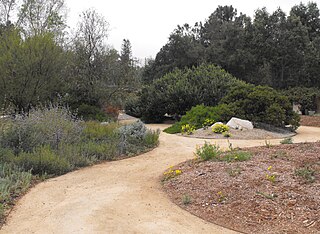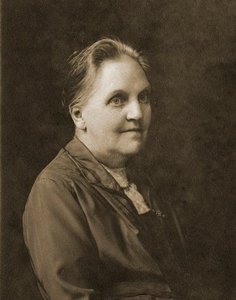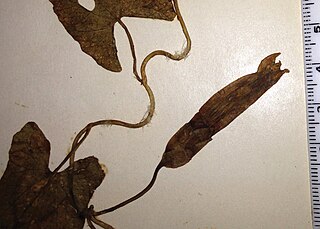Related Research Articles

The California Botanic Garden is a botanical garden in Claremont, California, in the United States, just south of the San Gabriel foothills. The garden, at 86 acres (35 ha), is the largest botanic garden in the state dedicated to California native plants. It contains some 70,000 native Californian plants, representing 2,000 native species, hybrids and cultivars. The seed bank has embryos for the thousands of rare plants.

Katherine Esau was a German-American botanist who received the National Medal of Science for her work on plant anatomy.

Willis Linn Jepson was an early California botanist, conservationist, and writer.

Annie Lorrain Smith was a British lichenologist whose Lichens (1921) was an essential textbook for several decades. She was also a mycologist and founder member of the British Mycological Society, where she served as president for two terms.
Cornelius Herman ("Neil") Muller, born Müller, was an American botanist and ecologist who pioneered the study of allelopathy and oak classification.

Rogers McVaugh was a research professor of botany and the UNC Herbarium's curator of Mexican plants. He was also Adjunct Research Scientist of the Hunt Institute in Carnegie Mellon University and a Professor Emeritus of botany in the University of Michigan, Ann Arbor.

The Cheadle Center for Biodiversity and Ecological Restoration (CCBER) is a research center under the Office of Research at the University of California, Santa Barbara (UCSB) whose mission is to preserve regional biodiversity and restore ecosystems on campus lands. CCBER has three main functions: curation and preservation of natural history collections, native coastal ecosystem and habitat restoration on campus lands, and education and outreach for both UCSB students and local community schools.

Robert F. Thorne was an American botanist. He was taxonomist and curator emeritus at Rancho Santa Ana Botanic Garden and professor emeritus at Claremont Graduate University in Claremont, California. His research has contributed to the understanding of the evolution of flowering plants.
Adolph Daniel Edward Elmer was an American botanist and plant collector. He was mostly active in the Philippines, his collections being described as new species by both himself and other botanists. The Japanese sent him into Santo Tomas Internment Camp during the Philippines campaign and he died there.
The University of Michigan Herbarium is the herbarium of the University of Michigan in Ann Arbor, Michigan, in the United States. One of the most-extensive botanical collections in the world, the herbarium has some 1.7 million specimens of vascular plants, algae, bryophytes, fungi, and lichens, and is a valuable resource for teaching and research in biology and botany. The herbarium includes many rare and extinct species.

Matilda Cullen Knowles is considered the founder of modern studies of Irish lichens following her work in the early twentieth century on the multi-disciplinary Clare Island Survey. From 1923 she shared curatorship of the National Museum of Ireland herbarium – a collection of dried and pressed plants now housed at the National Botanic Gardens. Her work is said to have "formed an important baseline contribution to the cryptogamic botany of Ireland and western oceanic Europe".
Mildred Esther Mathias was an American botanist and professor.

Caroline Priscilla Bingham was an American botanist who was one of the earliest American women to publish scientific papers on botany. She was an influential collector of botanical specimens discovering a new genus and several new species. As a result of her discoveries Bingham had a genus and several algae species named in her honor.

Josephine Elizabeth Tilden was an American expert on pacific algae. She was the first woman scientist employed by the University of Minnesota. Tilden established a research station in British Columbia which lasted only until 1906. When Tilden became an assistant Professor in 1903, she was the first female scientist employed by the University of Minnesota. In 1910, despite not having a doctorate, Tilden was promoted to full professor.

Edith Gertrude Clements (1874–1971), also known as Edith S. Clements and Edith Schwartz Clements, was an American botanist and pioneer of botanical ecology who was the first woman to be awarded a Ph.D. by the University of Nebraska. She was married to botanist Frederic Clements, with whom she collaborated throughout her professional life. Together they founded the Alpine Laboratory, a research station at Pikes Peak, Colorado. Clements was also a botanical artist who illustrated her own books as well as joint publications with Frederic.
Annetta Mary Carter was an American botanist.
Jean H. Langenheim was an American plant ecologist and ethnobotanist, highly respected as an eminent scholar and a pioneer for women in the field. She has done field research in arctic, tropical, and alpine environments across five continents, with interdisciplinary research that spans across the fields of chemistry, geology, and botany. Her early research helped determine the plant origins of amber and led to her career-long work investigating the chemical ecology of resin-producing trees, including the role of plant resins for plant defense and the evolution of several resin-producing trees in the tropics. She wrote what is regarded as the authoritative reference on the topic: Plant Resins: Chemistry, Evolution, Ecology, and Ethnobotany, published in 2003.
Geneva Sayre was an American bryologist and bibliographer. She "pioneered bibliographical and historical bryology, a new field in the study, evaluation, and organization of the literature of bryology."
Herbert LouisMason (1896–1994) was an American botany professor, plant collector, and herbarium director.
Billie June McCaskill, better known as June McCaskill, was an American herbarium curator at the University of California, Davis and expert in weed identification.
References
- ↑ International Plant Names Index. S.C.Tucker.
- 1 2 3 4 5 "Shirley and Kenneth Tucker Fund mover herbarium forward" (PDF). Lasthenia: Newsletter of Davis Botanical Society: 1, 5. Summer 2015.
- ↑ "United States Census, 1940," database with images, FamilySearch (accessed 10 July 2019), Minnesota > Hennepin > Minneapolis City, Minneapolis, Ward 12 > 89-380 Minneapolis City Ward 12 (Area 90 part) > image 8 of 35; citing Sixteenth Census of the United States, 1940, NARA digital publication T627. Records of the Bureau of the Census, 1790 - 2007, RG 29. Washington, D.C.: National Archives and Records Administration, 2012.
- 1 2 3 4 Gentile, Angelo (2000). "A Career that Blossomed". Plant Science Bulletin. 46 (1).
- 1 2 "Kenneth Tucker: 1924-2014". ANR Blogs. Retrieved 2019-07-09.